Affordable 2-in-1 detachable notebooks triple threat: Acer vs. ASUS vs. HP
The spirit of the netbook lives on
Remember netbooks? Those portable, tiny, modestly powered and inexpensive machines that preceded tablets? If not, here’s a little trip down memory lane.
Netbooks were introduced in 2007 and was made popular by the ASUS Eee PC. It sold over 300,000 units in four short months, and soon every other major PC manufacturer was making netbooks. Costing around S$500, they were extremely popular for a while. But they soon fell out of favor once the iPad and other tablets came along. Since netbooks were designed primarily for light computing tasks like word processing, web browsing and watch videos; users soon found that tablets could do the same and often offered a better, smoother and more responsive experience.
Now, however, it seems like they are making a bit of a comeback. And for that we have to thank falling flash memory prices. The biggest problem with traditional netbooks was that there were much bulkier compared to tablets and they were woefully slow. And the reason they were so slow was that most of them relied on mechanical hard disk drives for storage. Flash memory was pricey back then, and to provide them on a netbook would drive prices up considerably. Fortunately, flash memory is considerably more affordable and using such memory for storage in small, portable notebooks have improved performance and user experience tremendously.
Falling flash memory prices aside, another reason for their reemergence can be attributed to Windows 8.1 with Bing. Windows 8.1 with Bing is essentially a royalty-free version of Windows 8.1 and is offered for free to any manufacturer that is building low-cost systems. Without the need to pay royalties, manufacturers can keep the price of these devices even lower.
These reasons have led to a resurgence in small, low-powered notebooks. And today we are going to take a look at three of such machines. But that’s not all, these three are not just regular notebooks, they are in fact 2-in-1 detachable devices with detachable displays that can fulfill the dual roles of tablet and notebooks. And best of all, they all come in at under S$600. Can there really be a cheap and cheerful 2-in-1 detachable notebook? We find out.
Acer Switch 10E

When it comes to bang for buck, one of the names that get thrown around often is Acer. Although the brand has remained relatively quiet lately, it remains to be one of the top five PC manufacturers in the world. Figures from Gartner indicates that it is the number four PC maker in the world, accounting for 7.9% of all PC shipments in 2014 - behind Lenovo, HP and Dell, but ahead of Taiwanese compatriots ASUS.
As its name suggests, the Acer Switch 10E has a 10.1-inch IPS display. The display supports HD resolution, in other words a resolution of 1,280 x 800 pixels and a pixel density count of about 150 pixels per inch. The display is touch-enabled and supports up to 10-points of multitouch. In our experience, the Switch 10E’s touchscreen is suitably responsive to use. And because it is an IPS panel, viewing angles are good and images look sharp despite the somewhat low resolution. However, the Switch 10E’s display lacks contrast and is glossy and highly reflective, which makes viewing a pain in brightly lit environments.
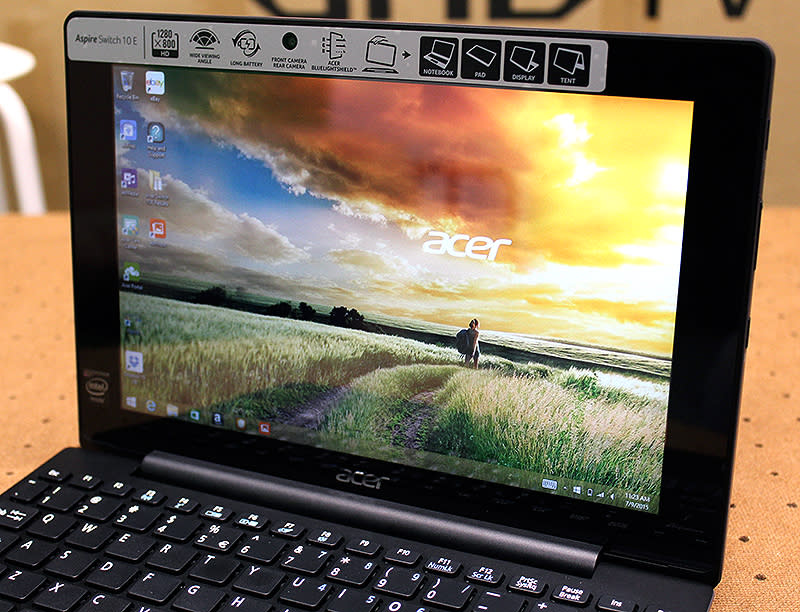

The Switch 10E has an all-plastic chassis and is also rather thick, coming in at around 25.7mm thick with the keyboard dock attached. The tablet display alone is around 8mm thick. It’s not particularly light either. With the keyboard dock attached, it weighs 1.28kg - the tablet display alone is 630g. As a result, it looks rather porky, but at least it comes in an interesting color and the chassis has unique textures running across it so it doesn’t look too bland. Nevertheless, we don’t think the Switch 10E looks particularly attractive when compared to the other two 2-in-1 detachable devices compared here.

Inside, the Switch 10E is powered by a quad-core Baytrail Intel Atom Z3735F (1.33GHz, 2MB L2 cache) processor. It also features the Intel HD Graphics integrated GPU, a very basic integrated GPU solution with just 4 executions units. All in all, the Atom Z3735F is a fairly entry-level processor in Intel’s Baytrail family of Atom processors. Graphics processing duties are handled by integrated Intel HD Graphics GPU. This is a stripped down version of the integrated GPUs found on Intel’s Ivy Bridge processors. It has just four execution units and a maximum boost clock speed of 813MHz. A more modern Intel integrated GPU such as the Intel HD Graphics 6000 for instance has 48 execution units and a maximum boost clock speed of 1GHz.
Complementing the Intel Atom Z3735F processor in the Switch 10E is also 2GB of RAM. To keep prices down, the Switch 10E has 32GB of eMMC flash storage. eMMC flash storage no match for a proper SSD, but it is still miles faster than a traditional hard disk drive. It is also compact, allowing it to work well in devices such as tablets and ultra-thin notebooks and detachables. Now this is where the thickness of the Switch 10E pays off, because within the keyboard dock is actually a 500GB mechanical hard disk drive. 500GB is plenty and will allow users to store plenty of photos, music and videos for entertainment. The Switch 10E also has a security feature called Acer SwitchLock, which automatically locks the hard disk in the dock whenever the tablet is removed, thus preventing unauthorized access. Data on the drive is locked even if the drive has been physically removed.

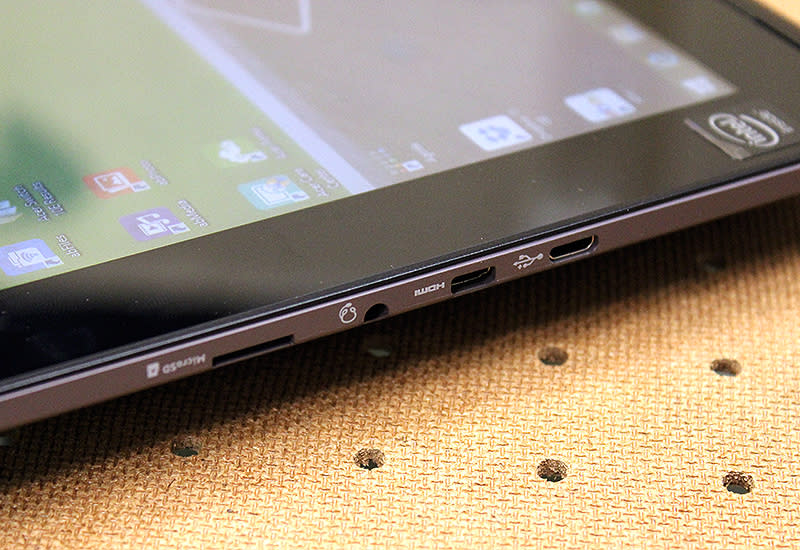
As for ports and connectivity, the thick keyboard dock means that Acer has been able to fit a full-sized USB port into it, albeit one that uses the older USB 2.0 standard. The tablet display itself has a mini-HDMI port for video output and a micro-USB port that also doubles up as its charging port. There's also a microSD card reader for expanding storage on the tablet display, since 32GB is not sufficient if you want to install lots of Windows apps on it. As for wireless connectivity, the Switch 10E uses a Realtek RTL8723BS wireless adapter which supports Bluetooth 4.0, but only Wireless 802.11n standard and up to 150Mbps throughput.
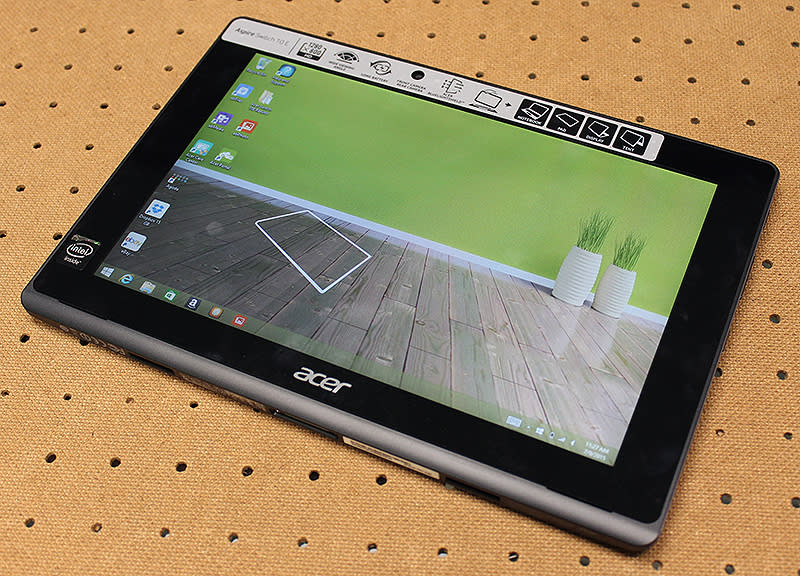

In terms of general usability, the Switch 10E has points deducted for its relative heftiness and bulk. It’s curved and round chassis means it's quite bulky and doesn’t feel quite handy to carry, whether you are using it as a notebook or as a tablet. However, that said, the thick keyboard dock also means that the keys themselves have quite a fair amount of travel and feel quite tactile. And though the keys are smaller than what you’d find on a typical notebook, they are still very usable. The trackpad is also well sized and responsive to use. The speakers are concealed but are located towards the bottom left and right corners of the display. Unsurprisingly, the speakers are unimpressive, lacking body and clarity; and are also a bit soft.
ASUS Transformer Book T100 Chi
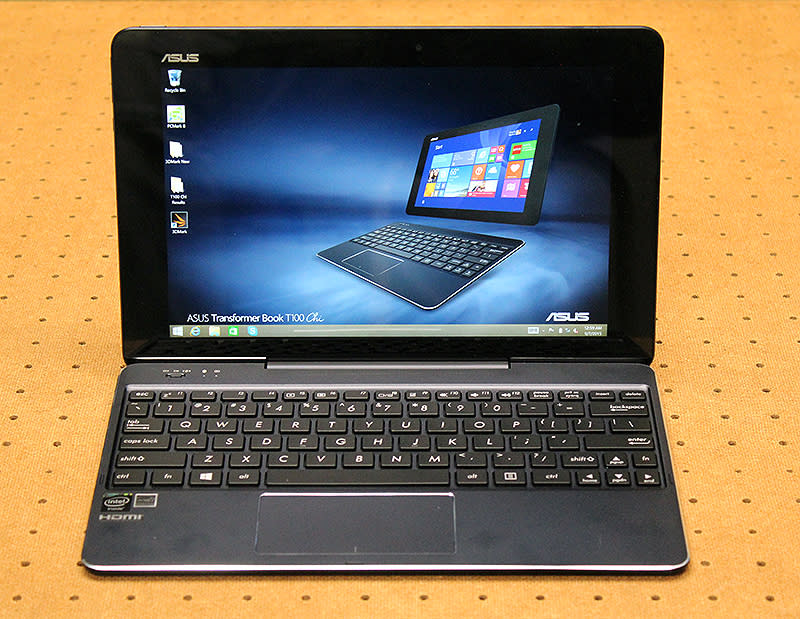
ASUS is no stranger to 2-in-1 detachable devices, having only released the excellent Transformer Book T300 Chi just a couple of months ago. As we noted in our review, the Transformer Book T300 Chi was and still is one of the best implementations of Intel’s new Core M processor that we have seen and fulfills the dual roles of notebook and tablet to a great degree. So how do you build on that success? The answer, it seems, is really quite simple: just shrink the Transformer Book T300 Chi.
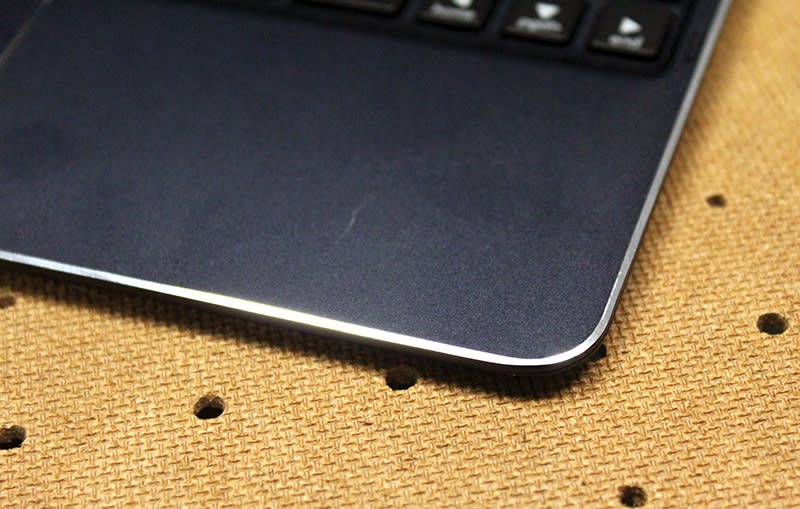
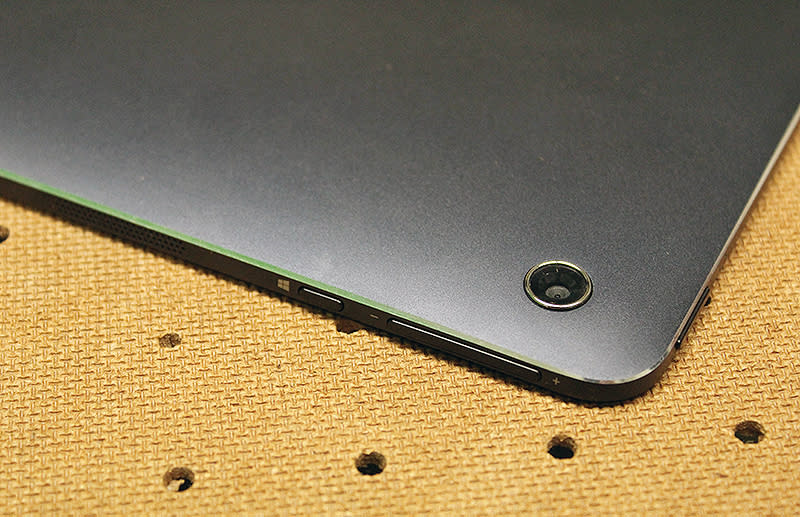
On the outside, the Transformer Book T100 Chi looks just like a smaller version of the Transformer Book T300 Chi. Like the T300 Chi, the T100 Chi has an aluminum chassis that feels solidly put together. It even has the same chamfered diamond-cut polished edges, that gives the entire device more visual flair. It is remarkable thin too, measuring just 14.8mm thick with the keyboard dock attached. The tablet display alone is just 7.2mm thick - slightly thinner than the first generation iPad Air. It’s light too, the tablet display weighs just 570g; and with the keyboard dock attached, the entire device is weighs just slightly more than a kilogram.
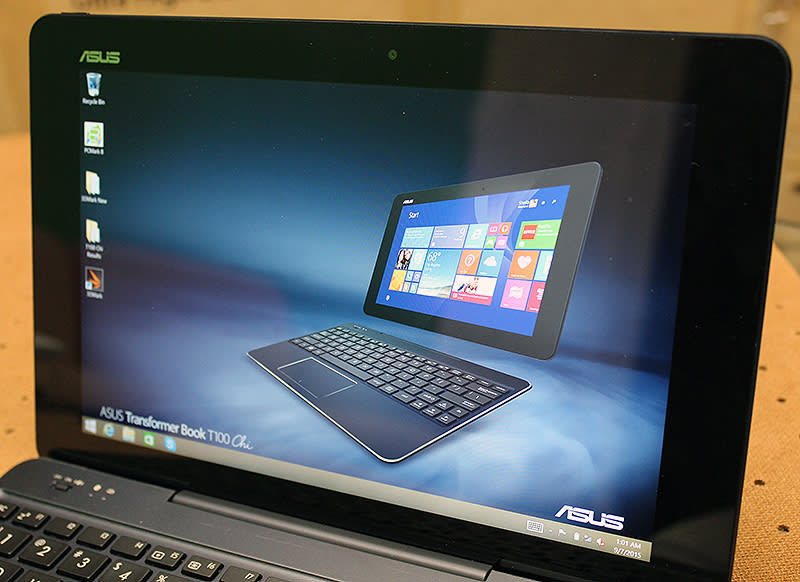
The smaller Transformer Book T100 Chi has a 10.1-inch display that outputs a resolution of 1,920 x 1,200 pixels. This gives it a pixel density count of 224 pixels per inch, on a par with Apple’s MacBook Pros with Retina display. This also means that text and images on the Transformer Book T100 Chi appear incredibly sharp and crisp. Noticeably so when you compare it against the Acer and HP machines that we have rounded up here. Viewing angles are good too, but the display suffers from a lot of glare and reflection. Touch sensitivity is good and accurate, so detaching the Transformer Book T100 Chi from its keyboard dock and using it as a tablet should not be an issue.
Underneath, the Transformer Book T100 Chi is powered an Intel Bay Trail Atom processor, specifically the quad-core Atom Z3775 (1.46GHz, 2MB L2 cache). This is a fairly high-end Atom processor and it runs at slightly higher clock speeds than the processors found in the Acer and HP devices. It also features an Intel HD Graphics integrated GPU with four execution units, but the Atom Z3775 can achieve higher maximum boost clock speeds of up to 778MHz - versus 646MHz in the Atom Z3735F and Atom Z3736F in the Acer and HP machines. This should translate to marginally better graphics performance. Complementing the Atom Z3775 processor is 2GB of RAM and 64GB of storage using eMMC flash memory. In sum, the specifications of the Transformer Book T100 Chi is very comparable to the Acer and HP machines, save for its slightly faster processor.
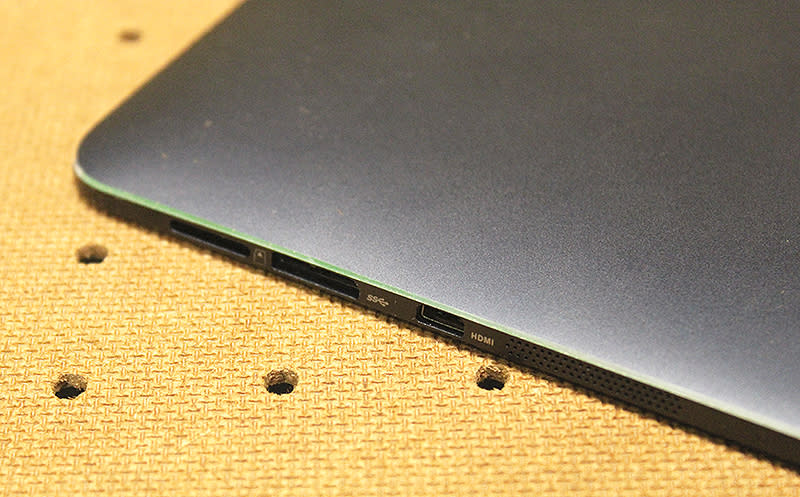
As for connectivity, the Transformer Book T100 Chi has a micro-USB port and another USB 3.0 port using the micro-B plug. There’s also a micro-HDMI port, a 3.5mm audio jack and a microSD card slot for increasing storage. It uses a Broadcom wireless adapter that only supports Wireless 802.11n standard and throughput speeds of up to 150Mbps. Bluetooth 4.0 is also supported.


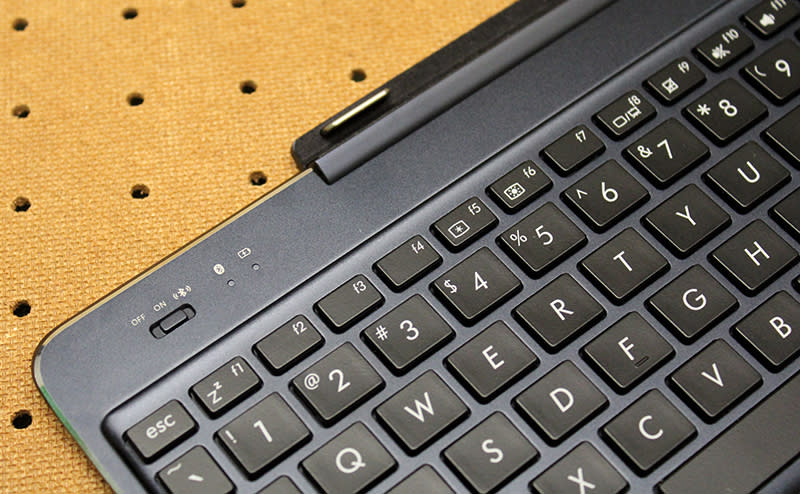
Given the Transformer Book T100 Chi’s lightweight and slim design, it’s no surprise to find that out of the three machines we have gathered here, it fulfills the role of a tablet the best. The high resolution display coupled with the responsive touchscreen, slim design and aluminum body, means that it feels just like a premium tablet. The keyboard dock is a joy to type on as well, but the touchpad is far too narrow to be used comfortably. But our biggest issue with the Transformer Book T100 Chi’s keyboard dock is that it works like a separate accessory. It connects to the T100 Chi via Bluetooth and a powerful magnetic hinge, but it doesn’t draw power from the main tablet unit itself - it needs to be charged separately to work. Fortunately, ASUS claims that the keyboard dock will last around 84 hours between charges, but we would definitely have preferred that the dock drew power directly from the tablet display.
Audio performance was nothing to shout about, given the compact size of the device. Even at maximum volume, the Transformer Book T100 Chi sounded soft. Furthermore, bass was almost non-existent and the general sound can be described as thin - best to use headphones or pair it with external speakers if you wish to watch movies or listen to music on it.
HP Pavilion x2

Depending on your source, HP is either the number one or two PC manufacturer in the world. Regardless, HP has often placed a great emphasis on design, as evidenced by the new Spectre x360, and this focus on design can be seen and felt in their new Pavilion x2 2-in-1 detachable notebook too.
Announced in June, the Pavilion x2 is arguably the funkiest looking of the trio of 2-in-1 devices that we have gathered here. To begin, it is available in two striking colors, Sunset Red and Blizzard White - there’s no boring black or grey. The application of paint is thorough and the entire device has an even matte finish. Thanks to the well applied paint, the Pavilion x2 does not come across as cheap-looking at all despite its all plastic construction.
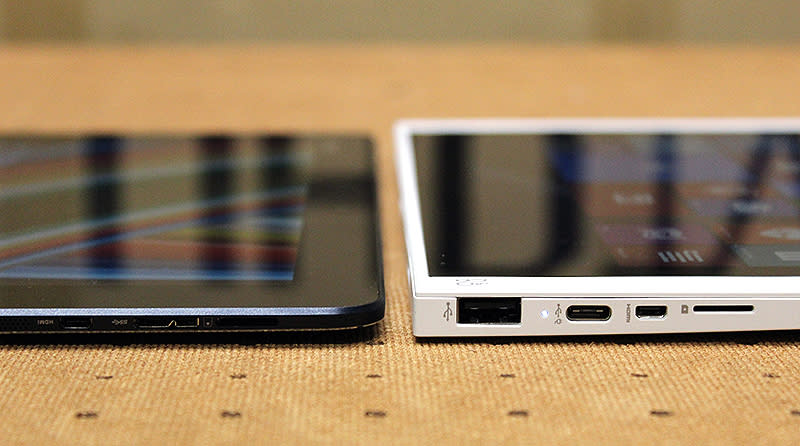

The Pavilion x2 is very compact and portable. In fact it is HP’s thinnest detachable PC ever at just 16.75mm thick - with the keyboard dock attached. At 9.65mm thick, the tablet is a little on the thick side compared to its rivals here, but there’s a good reason for it which we will get into later. As for weight, the entire device weighs 1.13kg, while the tablet display alone is around 590g.
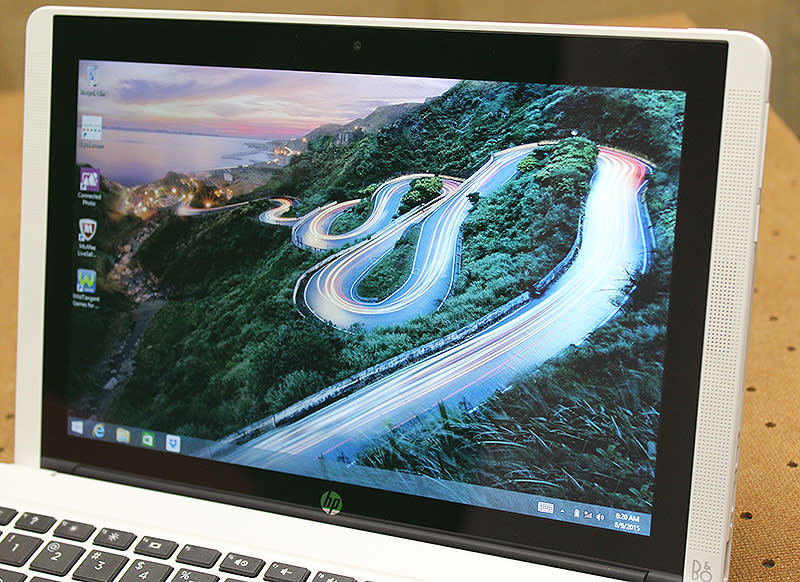
Like the other two 2-in-1 detachable notebooks before, the Pavilion x2 has a 10.1-inch touchscreen display that supports up to 10-points of multitouch. Touch sensitivity is good and responsive, so we had no problems using the Pavilion x2 as a tablet. One potential downer is that the screen only supports a resolution of 1280 x 800 pixels, which gives it a pixel density count of just 150 pixels per inch - a tad low by today’s standards. That said, you’ll only notice the difference if you look really hard as images and text still look passably sharp. Colors are also brighter and more vibrant than the other two machines. Viewing angles are good too.
Diving deeper, the Pavilion x2 is powered by a quad-core Intel Bay Trail processor, specifically the Atom Z3736F (1.33GHz, 2MB L2 cache). This processor shares nearly identical specifications with the Atom Z3735F processor from the Acer Switch 10E. The only notable difference is that the Atom Z3736F can boost to higher clock speeds - 2.16GHz vs. the Atom Z3735F’s 1.83GHz. The Atom Z3736F also features Intel HD Graphics integrated GPU with four execution units. The Pavilion x2 also comes with 2GB of RAM and 64GB of eMMC flash memory storage.
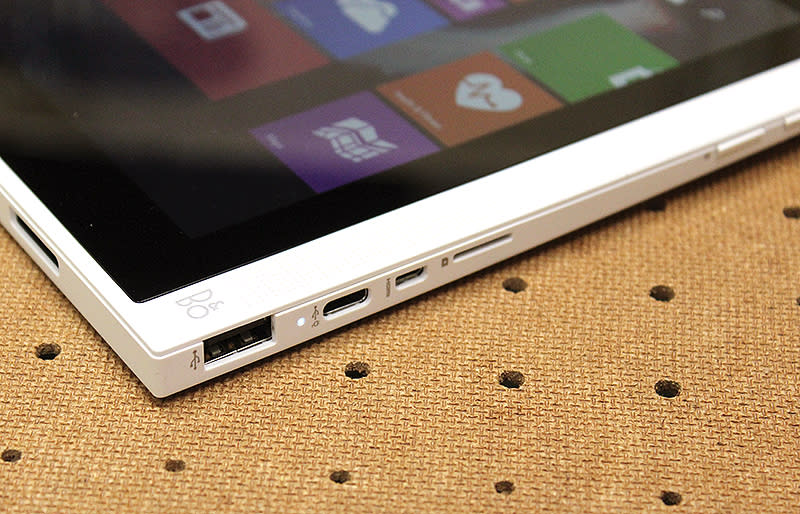
Now, the reason why the tablet display is thicker than its rivals is because it packs a full-sized USB 2.0 port. This makes connecting external storage devices and peripherals a breeze. On top of that, the Pavilion x2 also has a USB Type-C port, which can be used to charge the device and also use with USB Type-C accessories. The unfortunate thing, however, is that this USB Type-C port only supports USB 2.0 throughput speeds. Elsewhere, the Pavilion x2 has a micro-HDMI port, 3.5mm audio jack and a microSD card reader for increasing storage. Wireless duties are handled by the Realtek RTL8723BS wireless adapter (identical to the Acer Switch 10E), which supports Bluetooth 4.0 and only a Wireless 802.11n standard with throughput speeds of up to 150Mbps.
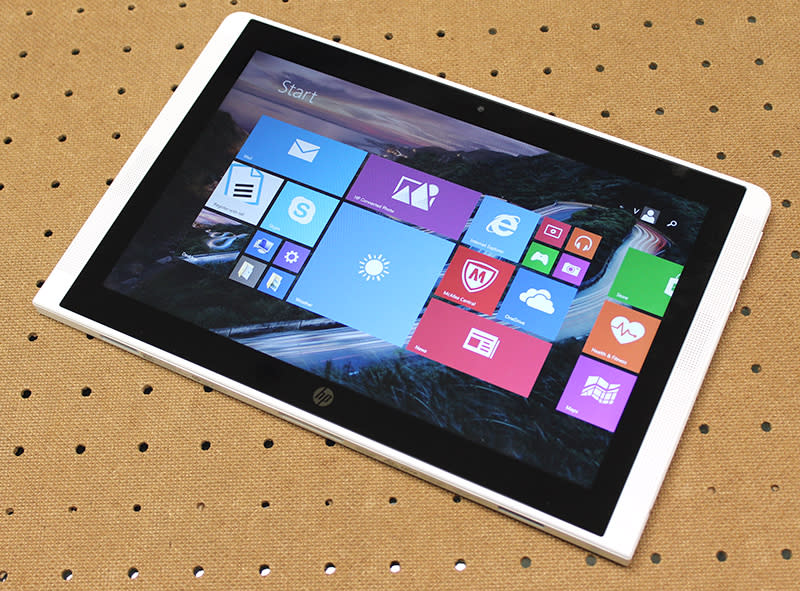
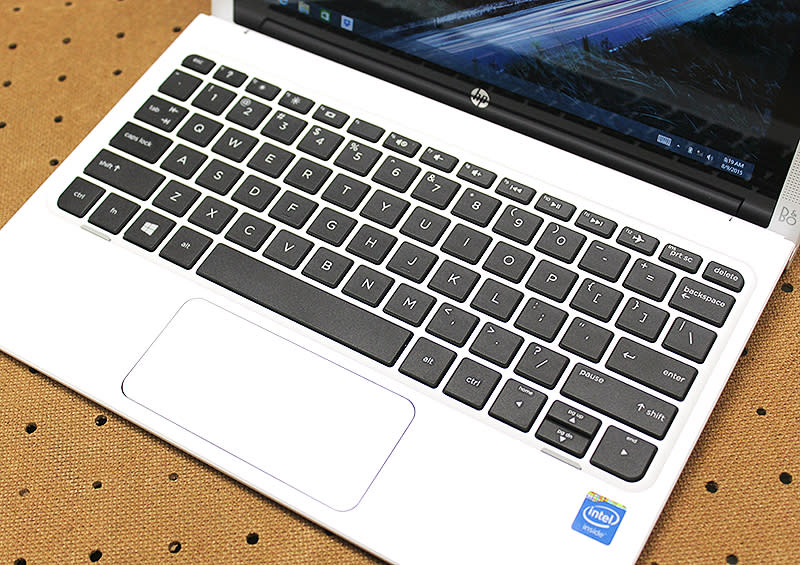
Like its rivals here, the Pavilion x2’s keys are a little smaller and takes some getting used to, but the feel is good and you can type pretty quickly once you get adapted to the smaller size. The trackpad, however, is wide but a tad too narrow, making it hard to scroll up and down. But the bigger issue with the trackpad is that it is extremely unreliable to use. Many times we gave up and used the touchscreen display instead. And though the tablet display is thicker than competition, the thickness is really only on just one side. This also means that the tablet display is shaped like a wedge, which actually makes it easier to handle.
The Pavilion x2 has Bang & Olufsen branded speakers and it's the only ones that are forward facing. In terms of audio performance, the Pavilion x2 is noticeably more powerful than its rivals. It sounds appreciably louder and stronger - there's stronger bass and clearer, more powerful vocals. But even so, those observations are relative to the competitors and audio performance in general is still poor and headphones/speakers are a must if you really want to enjoy music or videos on the Pavilion x2.
Performance Benchmarking
We will be evaluating the three 2-in-1 detachable notebooks using our usual suite of benchmarks. However, some test runs were left out because they could not be completed. For example, we left out the "Storage" from PCMark 8 because not all machines could complete the test run. We also left out the "Adobe" suite because these are all 32-bit machines and therefore cannot run the 64-bit versions of Adobe applications that are required for the test. We also left out the "Fire Strike" test from 3DMark because the integrated GPUs in this class of machines simply cannot cope with the intensive requirements of that test scenario.
And as for comparison, we will be including results from other recently tested 2-in-1 detachable devices and ultraportable notebooks including the Microsoft Surface 3, which is also powered by an Intel Atom processor, albeit the newer and more powerful Atom x7-Z8700. We have also included results from the ASUS Transformer Book T300 Chi, Lenovo Yoga 3 Pro, Apple MacBook and Microsoft Surface Pro 3.
Here's a quick look at how the the three 2-in-1 detachable notebooks compare against each other.
|
|
|
|
|
|
|
|
|
|
|
|
|
|
|
|
|
|
|
|
|
|
|
|
|
|
|
|
|
|
|
|
|
|
|
|
PCMark 8
Given that the ASUS Transformer Book T100 Chi had a higher base clock speed than the Acer Switch 10E and HP Pavilion x2, we were not surprised to see that it eked out a slight lead over its two rivals across all scenarios in PCMark 8. On “Home” and “Work”, the Transformer Book T100 Chi was about 7% faster, while on “Creative” and “MS Office” its lead was extended to around 16%. The Switch 10E and Pavilion x2 were about neck-to-neck. The numbers of these three devices were also quite close to the new Microsoft Surface 3, despite the latter having a newer and more powerful Atom x7-Z8700 processor. That said, these machines were no match even for Core M-powered devices like the Apple MacBook, ASUS Transformer Book T300 Chi and Lenovo Yoga 3 Pro.

3DMark 2013
We normally report 3DMark 2013 performance with results from both Cloud Gate and the more intensive Fire Strike test scenario, however the Intel HD Graphics integrated GPU within these three machines were too underpowered to complete that test.
Again, the ASUS Transformer Book T100 Chi was the leader, managing 1388 points - around around 22% more than the Acer Switch 10E and HP Pavilion x2. But to put these results into perspective, it's only about half of what Core M devices like the Apple MacBook and Lenovo Yoga 3 Pro can achieve. The runaway leader here was the Dell XPS 13, which was powered by the far more powerful Intel HD Graphics 5500 integrated GPU. To further clarify, the Intel HD Graphics integrated GPU only has 4 execution units, whereas the Intel HD Graphics 5500 integrated GPU has 24 execution units. What's also worth noting is that the Microsoft Surface 3 managed to score about 56% more than the Transformer Book T100 Chi, despite being powered by an Atom processor as well.

Far Cry 2
Judging from the earlier results on 3DMark 2013, we were not expecting much from Far Cry 2. Even the most powerful device of the trio - the ASUS Transformer Book T100 Chi - only managed a measly 10.52 fps on "Normal" settings. Bear in mind that Far Cry 2 will be turning seven years old next month. Clearly, Atom processors are lacking the necessary firepower for even light and casual gaming. With these devices, you would be limited to just playing games off the web. And despite the Microsoft Surface 3's encouraging showing on 3DMark 2013 earlier, it wasn't that much faster than the Acer, ASUS and HP devices. If you really want to do some gaming, best to get a more powerful system like the Dell XPS 13. At least with its Core i7-5500U processor and Intel HD Graphics 5500, the XPS 13 could manage slightly playable frame rates.

Tomb Raider
Tomb Raider is a much more modern and intensive title and needless to say, the three devices were completely hopeless here. Nevertheless, what's important is that even under such circumstances, the ASUS Transformer Book T100 Chi was able to maintain its performance superiority over the Acer Switch 10E and Pavilion x2 - even if this superiority is meaningless in the grander scheme of things. The Microsoft Surface 3 also performed significantly better than the three devices here, but again, the performance advantage is not really beneficial at all since its well below the playable frame rate threshold of 30 fps. Note that even the Dell XPS 13 struggles here, which shows that integrated graphics still have quite some ways to go before it is able to be reliably called upon for gaming.

Battery Life & Power Consumption
The Acer Switch 10E's battery life was easily the longest, coming in at 462 minutes - that's 7 hours and 42 minutes! It's also double that of the ASUS Transformer Book T100 Chi, which, despite having the same capacity battery as the Switch 10E, only managed a disappointing 231 minutes or 3 hours and 51 minutes. The HP Pavilion x2 did well too, coming at 6 hours and 35 minutes, but that's still over an hour shorter than the Switch 10E. Looking at their power consumption figures, we can see that the Transformer Book T100 Chi was the most power hungry, perhaps due to its much higher resolution display and slightly more powerful processor. The three machines also compare well to the Microsoft Surface 3.


Portability Index
Our Portability Index factors in battery life, weight and volume so you can see which notebook is the most worthwhile to carry around. Unfortunately, the Acer Switch 10E's long battery life wasn't able to do much for it as it was outscored by both the ASUS Transformer Book T100 Chi and HP Pavilion x2. The problem is that the Switch 10E is simply too bulky compared to its rival. Looking at the scores here, the Pavilion x2 is easily the most portable amongst the trio. The three devices were also outscored by the super slim Apple MacBook which is a notable feat considering its size and specs. The Microsoft Surface 3 was the runaway leader thanks to its extremely compact dimensions.

Thoughts on affordable 2-in-1 devices
In many ways, the three devices that we have rounded up here are the spiritual successors to the netbook. They are relatively affordable and they can do just about anything a regular desktop or notebook can - minus gaming, of course. But they do have some of the same drawbacks that netbooks of the past did.
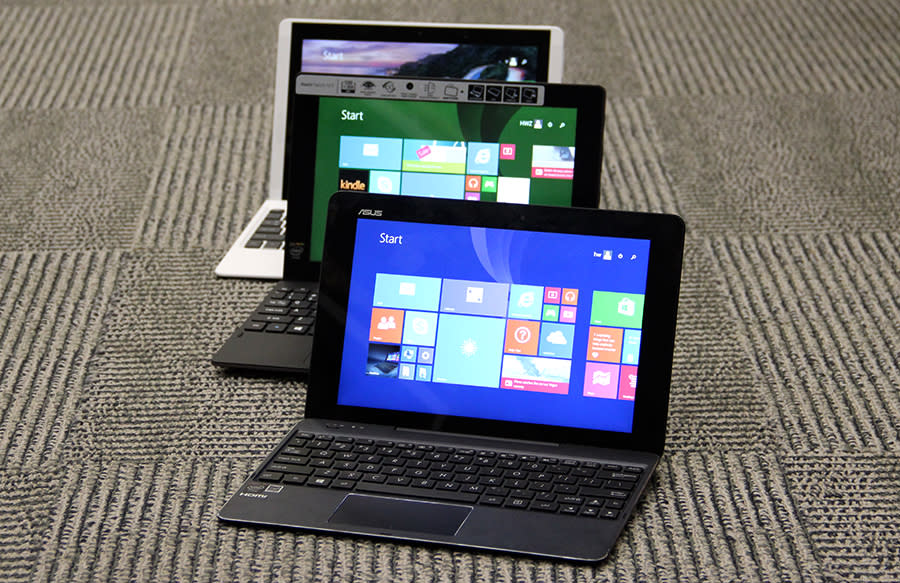
To begin, because of their compact size, typing on them needs quite a bit of readjustment, depending on how adaptable you are as a typist. The keys, for instance, are about 93% the size of regular keyboards, and though that doesn’t sound like much, the effects are quite profound and we are willing to bet that most users will have problems typing fluently at least in the beginning.
And despite generally being quite brisk to use, the gulf in performance between these devices and regular notebooks (like the Dell XPS 13 or even a Microsoft Surface Pro 3 or MacBook Air) is actually quite wide. Although the fall in flash memory prices has made it economically viable for brands to outfit these devices with faster flash storage, the same can also be said for most notebooks these days as well. Many brands are now offering SSDs in their notebook offerings and such models are pretty affordable too, often with prices beginning at around the S$1000 mark. As a result, these “entry-level” notebooks, despite their less powerful Intel Core processors, still feel pretty fast to use. In other words, although these affordable 2-in-1 devices have caught up to regular desktop and notebooks in terms of performance, users should expect to still see and feel a noticeable difference in performance.
However, there are some good things about these devices. Crucially, they are true and good alternatives to your iPads and Android tablets. The Acer Switch 10E, ASUS Transformer Book T300 Chi and HP Pavilion x2 are all comparable to any modern tablet out there today, in terms of both usability, price and design. We would even argue that they are more useful, since they run full Windows and can do just about anything a regular desktop or notebook can. This is good for users who are so used to or reliant on desktop operating systems and apps that they cannot pry themselves away to use either iOS or Android. Furthermore, they are all relatively affordable especially when you consider that the entry-level 16GB iPad Air 2 is S$688. The only quibble we have is that this trio of devices don’t feel as fluid as iPads and Android tablets. But we guess that’s a fair trade off given that Windows has more functionality and therefore requires more resources to run briskly.
So, the answer to the question that we posed to in the beginning, "can there really be a cheap and cheerful 2-in-1 detachable notebook?", is a resounding yes.
Final Analysis
In terms of performance, the three devices that we have rounded up here performed quite comparably. Though the ASUS Transformer Book T100 Chi had the lead on most of the benchmarks - thanks to its slightly faster processor - the fact is that you won’t notice the difference in real world usage scenarios. In fact, because of its higher resolution display, the Transformer Book T100 Chi would sometimes stutter when scrolling quickly. The high resolution display is really a double-edge sword, because even though images and text do look appreciably sharper and crisper on the Transformer Book T100 Chi, this has come at the cost of far poorer battery life and also a lesser fluid and responsive usage experience.
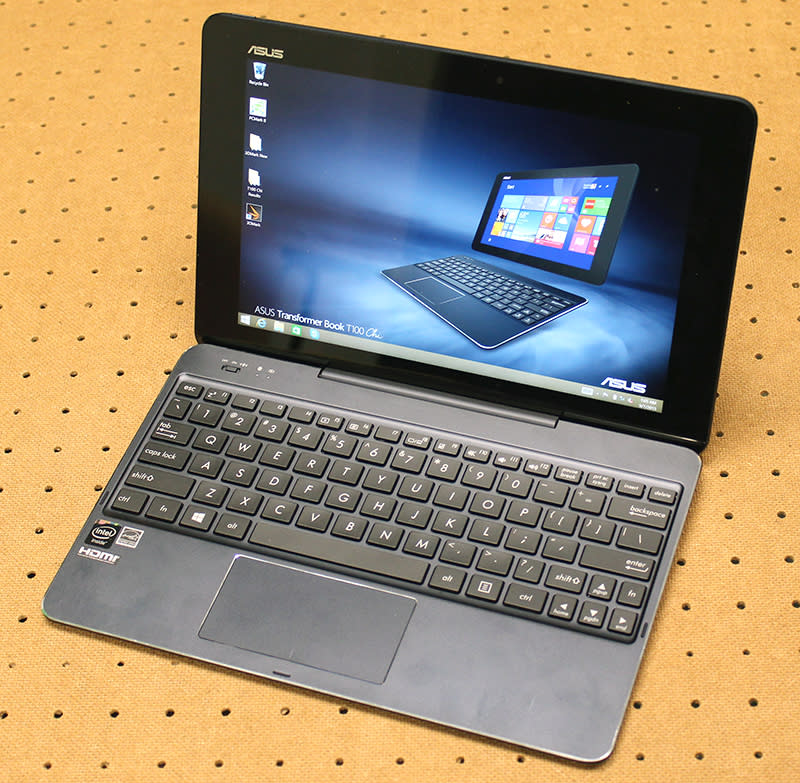
In other areas, the Transformer Book T100 Chi deserves praise for its high build quality and premium design. The chamfered diamond-cut polished edges are a nice touch and their device feels solidly put together. It’s also incredibly slim and light. However, these niceties come at a price because at S$599, the Transformer Book T100 Chi is priciest of the three here.
Unfortunately, some of the problems from the earlier Transformer Book T300 Chi are brought over onto this device. For example, the Bluetooth keyboard dock needs to be charged from time to time to work and does not draw power directly from the tablet display. Though the claimed battery life of the keyboard dock is adequately long, it’s still an inconvenience that could have been avoided. Besides, it’s not as if the Transformer Book T100 Chi’s tablet display has its own integrated kickstand like the Surface devices from Microsoft, which would allow users to use the keyboard dock away from tablet display. Another gripe we have about the Transformer Book T100 Chi is that it does not have a full-size USB port. Though this is unavoidable given the device’s slimness and ASUS does make up for this by providing a micro-USB to USB adapter, we think that they could have employed a similar design to the Pavilion x2 to get around this problem. The Pavilion x2 is not that much thicker, but it sports a full-sized USB port.
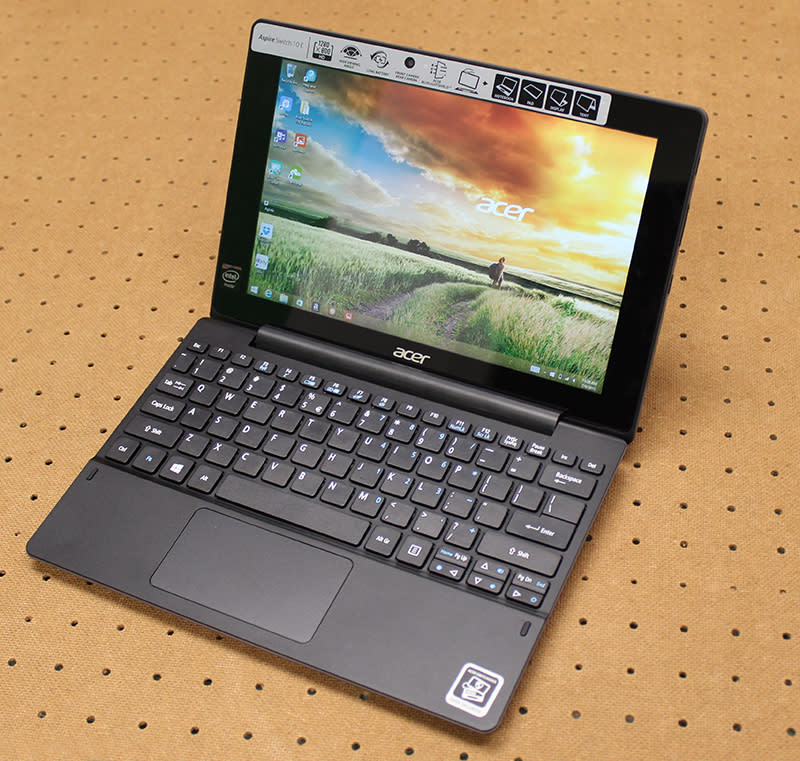
The Acer Switch 10E is arguably the most functional and practical device. Performance is about on a par with the HP Pavilion x2 and only slightly behind the ASUS Transformer Book T100 Chi so there’s nothing much to say about it here, but it makes up for its average performance with some useful features. Firstly, it’s battery life is off the charts, clocking in at an impressive 7 hours and 42 minutes - an hour longer than its closest rival. And it offers the most storage and that’s because its keyboard dock actually houses a mechanical HDD. This means it can store more photos, music and videos than its rivals. It's a thoughtful touch by Acer and shows that you do not need to sacrifice on storage capacity just to have a 2-in-1 detachable device.
However, this does mean that the Switch 10E is considerably bulkier than its rivals. And this is the Switch 10E’s biggest problem. Bulkiness aside, it doesn’t look particularly attractive either. Of course, beauty is in the eye of the beholder. But even if it does look a tad pudgy, it has a final redeeming feature and that’s its price. At S$499, it is the most affordable of the lot and considering all that it offers, we think it's good value for money.

It was hard to pick a winner, but the HP Pavilion x2 edges it for us. It does almost everything well and makes the best of what it has. For instance, even though it doesn’t have an aluminum chassis, HP has done a good job of masking that fact with a very good application of paint and funky colors, making the Pavilion x2 look not just more expensive than it really is, but also more fun and modern. What’s also great about the Pavilion x2 is how it manages to cram a full-sized USB port (and USB Type-C port) into the tablet display without compromising too much on the thickness and portability. Despite being the only device to have a full-sized USB port in the tablet display, it doesn’t feel much thicker at all - it’s a really good design. The Pavilion x2 is not just all about show either, performance is decent and battery life is pretty impressive too, coming at over 6 and a half hours.
Our only major issue with the Pavilion x2 is its erratic touchpad, which seems reluctant to cooperate with us no matter how we use it. Fortunately, this problem can be somewhat mitigated by using the touchscreen to perform inputs whenever the touchpad fails to play ball. It’s annoying to be sure, but not a complete deal-breaker in our books. And at S$549 it is priced in the middle of its two other rivals here, which is reasonable in the face of all that it offers.
Acer Switch 10E | ASUS Transformer Book T100 Chi | HP Pavilion x2 | |
|---|---|---|---|
7.0 | 8.5 | 8.5 | |
8.0 | 7.5 | 8.0 | |
7.0 | 7.5 | 7.0 | |
8.0 | 7.5 | 8.0 | |
7.5 | 8.0 | 8.5 | |
7.5 | 7.5 | 8.0 | |
S$499 | S$599 | S$549 |
 | |
 | |
 |






